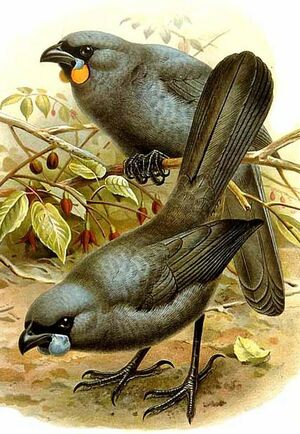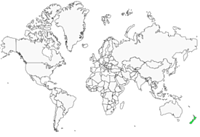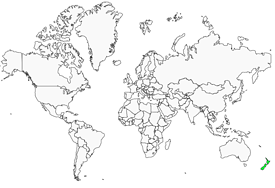South Island Kokako
Callaeas cinereus - Glaucope cendré
Identification
Endemic species, the South Island Kokako was the first described of the two species, the second being the North Island Kokako. It was slightly smaller and darker than the North Island Kokako. It is a blue-gray bird with a black mask, with black eyes. It has orange wattles, blue at the base, just below the mask, fleshy wattles that are folded under the throat at the corner of the black, short, slightly curved beak. It has a long, rounded, blackish tail, dark blue-gray legs, and rounded wings. The sexes are alike. Juveniles have pink wattles which turn orange with age.
Subspecific information monotypic species
Foreign names
- Glaucope cendré,
- Kokako de Isla Sur,
- cocaco-de-barbela-laranja,
- Orangelappenvogel,
- kokakó,
- Zuidelijke Kokako,
- Kokako,
- sydökokako,
- Sørkokako,
- laločník kokako,
- laločník šedý,
- Sydkokako,
- oranssihelttakookako,
- koralnik żółtopłatkowy,
- Южный кокако,
- ハシブトホオダレムクドリ,
- 垂耳鸦,
- 南島垂耳鴉,
Voice song and cries
The South Island Kokako makes a slow, low-pitched song, usually sung in a duet by the male and female. They also make a soft 'kuk-kuk' sound in calls. Unmistakable, the male has a very gentle, trilling whistle made of six notes, 'te, ta, tu, tu, tu, tu', and the female has a call made of five notes, like 'te, un, tu, tu, tu'.
Habitat
Early 1800s it was common and occupied the forest dominated by beeches, rata (Metrosideros excelsa), Kamahi (Weinmannia racemosa), and rimu (acrydium cupressinum), as well as the low scrub above the hill country on both sides of the Southern and Northwest Alps south of Nelson, in Fiordland, in the mixed podocarp forest on Stewart Island, as well as some wooded areas of Otago and Southland.
Behaviour character trait
The South Island Kokako is known to be potentially monogamous and territorial. Adult birds travel in pairs. Social groups have been observed with up to 7 birds feeding, and 20 birds in a single file line quickly jumping across the terrain, with a dominant leading them. McLean wrote They use their wings much more than Wilson's Kokako and show quite a good capacity for flight. It often uses its feet to hold its food like parrot species.
Flight
All callaeidae have rounded wings, a long tail, and limited sustained flight. It moves through forest by leaps, jumps, and gliding flights.
Dietfeeding habits
The diet of the South Island Kokako consists primarily of leaves and fruits, including Karamu (Coprosma robusta), New Zealand Goosefoot, Konini (Fuchsia excorticata), Tutu Coiyaria sarmentosa, and less often, of flowers, moss, buds, nectar, small insects and invertebrates.
Reproduction nesting
The nest is an elevated platform built in thick bushes, the support is made of twigs and small branches of wood, the nest of moss, sphagnum, and the cup is made of small herbs. The breeding season runs from October to February and laying eggs takes place from December to January. The eggs are off-white with brown and purple spots. The laying varies from 2 to 3 eggs. Only the female incubates. The incubation period and young dependence are unknown.
Threats - protection
IUCN conservation status
concern
in the Wild
threatened
evaluated
Populations have declined due to the accidental or intentional introduction of cats, ship rats, and stoats. This is the primary cause of the species' extinction. Predation has been the major contributing factor to its disappearance. Its tendency to feed on the ground and build a nest close to the ground made it more vulnerable to mammalian predators. Like the dimorphic Huia, it was described as ecologically not very wary. It allowed predators to approach the nest without alarm. Maori traditionally hunted it, and a large number were killed and sold to European collectors and museums. By the late 1800s it was already very rare. The last recorded sighting in the 20th century was in the Mount Aspiring National Park in 1967, yet a close sighting at Reefton on the West Coast of the South Island in 2007 was confirmed. If still present, it will only survive through the regulation (trapping and treating with 1080) of the areas it occupies. South Island Kokako.
Sources of information
- IOC World Bird List (v14.1), Gill, F and D Donsker (Eds). 2023.
- Handbook of the birds of the world Vol.14, josep del Hoyo
- Handbook of Australian, New Zealand and Antarctic birds, 1: ratites to ducks., Marchant, S.; Higgins, P. J.
- Know your New Zealand Birds, Lynnette Moon
- xeno-canto, Sharing bird sounds from around the world,
- Social and demographic characteristics of Blue Duck Hymenolaimus malacorhynchos., Williams, M.
- Avibase, Lepage Denis
- Conservation-comments-NZ,
- Wikipedia (English version),
Other sources of interest
 Specification sheet created on
01/08/2023 by Yann Cambon
Specification sheet created on
01/08/2023 by Yann CambonTranslation by AI Oiseaux.net
published: 31-01-2016 - Updated: 01-02-2016
© 1996-2024 Oiseaux.net
- Accipitriformes
- Aegotheliformes
- Anseriformes
- Apodiformes
- Apterygiformes
- Bucerotiformes
- Caprimulgiformes
- Cariamiformes
- Casuariiformes
- Charadriiformes
- Ciconiiformes
- Coliiformes
- Columbiformes
- Coraciiformes
- Cuculiformes
- Eurypygiformes
- Falconiformes
- Galliformes
- Gaviiformes
- Gruiformes
- Leptosomiformes
- Mesitornithiformes
- Musophagiformes
- Nyctibiiformes
- Opisthocomiformes
- Otidiformes
- Passeriformes
- Pelecaniformes
- Phaethontiformes
- Phoenicopteriformes
- Piciformes
- Podargiformes
- Podicipediformes
- Procellariiformes
- Psittaciformes
- Pterocliformes
- Rheiformes
- Sphenisciformes
- Steatornithiformes
- Strigiformes
- Struthioniformes
- Suliformes
- Tinamiformes
- Trogoniformes



